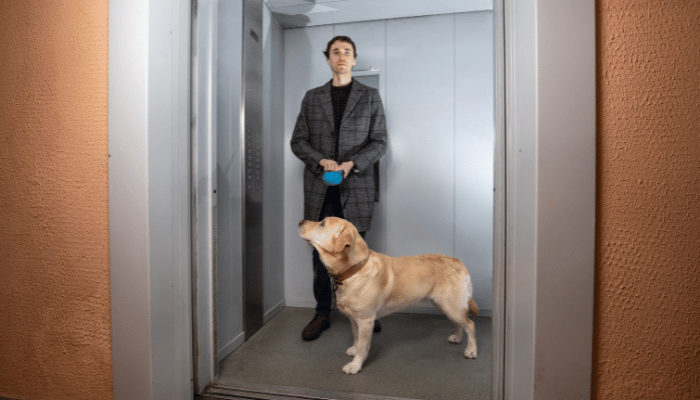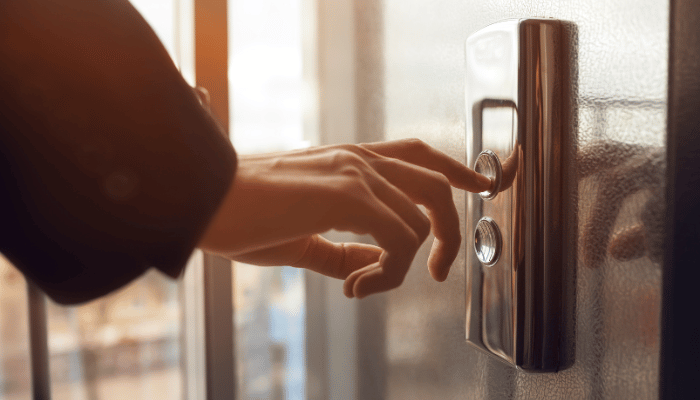
Is your four-legged companion part of your elevator routine? From curious cats to loyal pups, ensuring their safety during elevator rides is crucial. Join us as we explore essential tips and considerations to make elevator trips stress-free and safe for your pets. Whether moving to a high-rise or just wanting to ease the ride, learn how to create a pet-friendly residential home elevator that keeps tails wagging and purrs rolling.
Types of Pet Lifts
When accommodating pets in buildings with multiple floors, choosing the right type of pet lift for homes can significantly improve their comfort and safety. Here are some common types of pet lifts to consider.
Platform Lifts
Platform lifts are a versatile option suitable for both pets and their owners. They feature a flat platform that moves vertically between floors, making them ideal for larger pets or multiple animals at once. Platform lifts typically require less space than traditional elevators and can be customized to accommodate specific weight capacities and dimensions.
Pneumatic Lifts
Pneumatic or vacuum lifts operate using air pressure to move a transparent capsule or cabin between floors. These lifts are quiet, energy-efficient, and have a modern aesthetic appeal. They are suitable for smaller pets and are often preferred for their smooth, gentle ride experience.
Hydraulic Elevator
Hydraulic lifts use a hydraulic system to move a cabin or platform up and down between floors. They are known for their robustness and reliability and can handle heavier loads. Due to their strength and durability, hydraulic lifts are commonly found in residential and commercial settings.
Screw & Nut Elevator
Screw nut lifts operate using a screw mechanism to raise and lower a platform or cabin. These lifts are compact and can be installed in smaller spaces, making them suitable for homes with limited room for a traditional elevator. They are efficient and offer a smooth ride, making them suitable for pets sensitive to sudden movements.
When selecting a pet elevator, consider your pet’s size and temperament, the available space in your home, and any specific mobility needs. Consulting with lift specialists and considering your pet’s comfort and safety needs will help you make the best choice for creating a pet-friendly environment in your home.

Safety Features to Look For in Pet Elevator
Ensuring the safety of your furry companions during elevator rides is paramount. Below are the key safety features to look for when choosing a pet elevator.
Secure Harnesses or Restraints
Look for lifts that offer secure harnesses or restraints to keep your pet safely in place during the ride. These can prevent pets from moving around excessively or trying to jump out, ensuring their stability and minimizing stress.
Weight Capacity Limits
Always adhere to the lift’s weight capacity limits. Exceeding these limits can compromise the lift’s functionality and safety, potentially leading to mechanical issues or accidents. Choose a lift that comfortably accommodates your pet’s weight without exceeding its capacity.
Emergency Stop Buttons
Emergency stop buttons are crucial in unexpected situations. They allow immediate halting of the lift’s movement, ensuring quick response times when pet safety or comfort is compromised.
Sensor Technology
Modern lift for dogs and pet may include sensor technology that detects obstacles or obstructions in the lift’s path. This can prevent accidents and injuries by automatically stopping or adjusting the lift’s movement if something unexpected is detected.
Stable and Sturdy Platform
Ensure the lift platform is stable and sturdy enough to support your pet comfortably. A stable platform reduces the likelihood of swaying or instability during the ride, providing your pet a smoother and safer experience.
Non-slip Surface
Opt for lifts with non-slip surfaces on the platform to prevent pets from slipping or losing their footing, especially if they are anxious or unfamiliar with elevator rides.
Accessibility Features
Consider lifts that offer accessibility features such as low entry thresholds or spacious cabins that accommodate pet carriers or mobility aids if needed. These features enhance ease of use and ensure a more comfortable experience for pets and owners.

Preparing Your Pet for the Lift
Introducing your pet to the lift gradually is essential for their comfort and confidence.
Introduce Your Pet Gradually
Start by allowing them to explore the lift when it’s stationary, using treats and positive reinforcement to create a positive association.
Harness Training
Harness training is crucial to ensure your pet remains secure during the ride. Practice using a harness or carrier inside the lift before using it for trips between floors.
Regular Inspections
Regular lift inspections, including checking safety features and functionality, are vital to ensure a safe environment for your pet. This includes testing emergency stop buttons and ensuring the platform remains stable and secure.
By taking these steps, you can help your pet feel more comfortable and relaxed during elevator rides, making the experience safer and more enjoyable for both of you.
Choose Reliable Lifts for Homes At SWIFT!
Discover the perfect solution for safely transporting your furry companions between floors. Swift Pet Lifts combine sleek design with robust safety features, including secure harnesses and reliable weight capacity. Whether you have a playful pup or a curious cat, our domestic lifts ensure a stress-free ride with every ascent. Enhance your home with the ultimate in pet-friendly innovation—contact Swift Lifts today and elevate your pet’s comfort to new heights.
FAQs
Safety precautions in lifts include regular maintenance checks, ensuring weight limits are not exceeded, keeping doors clear, and using emergency features responsibly to ensure passenger safety.
Pet lifts typically handle weights ranging from 100 pounds (about 45 kilograms) to 500 pounds (about 227 kilograms), depending on the specific lift model and configuration.
Pet lifts can be safe for most pets when used properly and within weight limits. However, individual pet behavior and comfort should be considered, especially for anxious or large pets, to ensure a stress-free experience.
Installing a pet lift requires professional expertise due to electrical and structural considerations. It’s recommended to consult with a qualified installer to ensure safety and compliance with building codes.
Pet lifts have weight restrictions that vary depending on the model and manufacturer. Choosing a lift that matches your pet’s weight is important to ensure safe and efficient operation.
Get In Touch!










